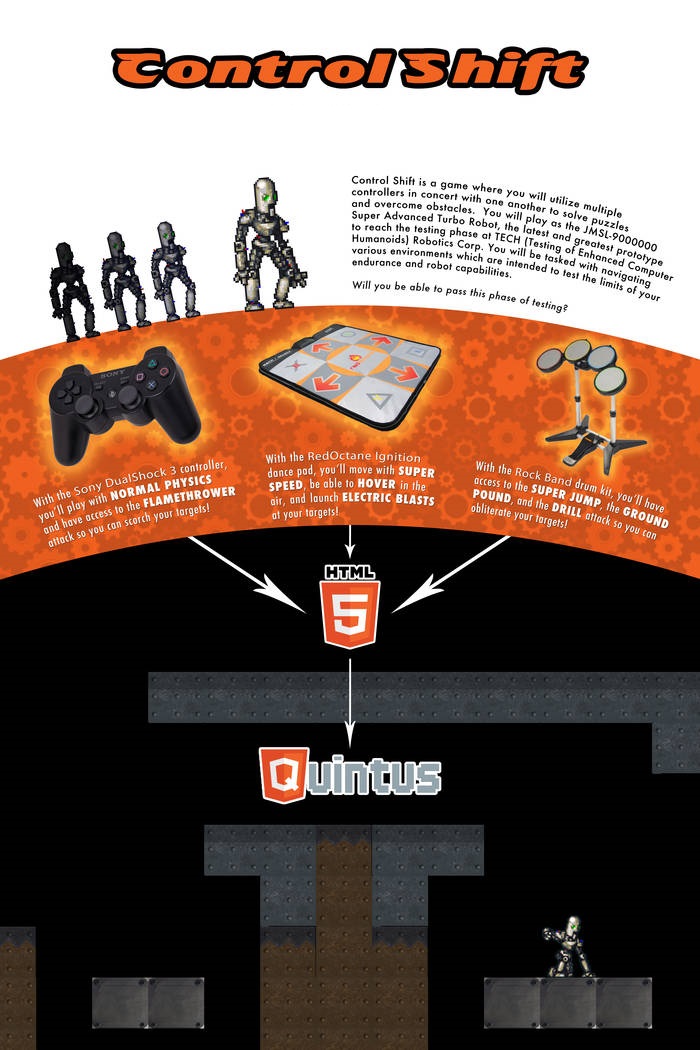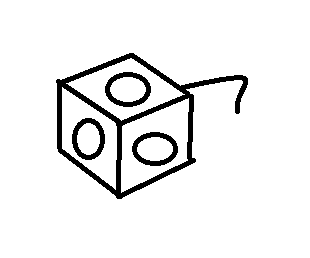|
|
Control ShiftProgramming Languages used: HTML5, CSS3, Javascript Play Here!Control Shift can be played by anyone. All you need is a USB dance mat, USB rockband drums, and a gamepad compatible with the Gamepad API. Once you have connected your gamepad you can test its compatibility with the API Here. The dance mat and drum set will need to be configured with ControlMK. Simply map the buttons on the dance mat and drum set to the keyboard keys listed in the section below and you are ready to play.

Abstract - Control Shift is a 2D platformer game that utilizes multiple controllers simultaneously to control a single player character. The controllers utilized are: the Sony Dualshock 3, the Red Octane Ignition dance mat, and the Rockband drums. The intent of Control Shift is to explore the areas of Human-Computer Interaction (HCI) and Cyberpsychology in relation to video games by observing how having multiple controllers that need to be used in concert with one another affects the single-player gaming experience. To facilitate this we have developed a game which requires use of all three controllers and conducted a small user study to collect qualitative feedback about the player experience. The player is encouraged to investigate the abilities at their disposal by exploring the three different control schemes presented to them. With Control Shift we hope to create a new and exciting type of controller-centric gaming experience.
I. INTRODUCTIONGame controllers typically play a passive role in the gameplay experience rather than being utilized by video games to create challenging and thought provoking gameplay puzzles. In recent years, video game console manufacturers have adventured into new territory by developing interfaces that do not rely on the typical button and joystick controllers that have existed relatively unchanged for decades. However, the games that are designed to make use of these novel control interfaces often fail to utilize the controls themselves as a significant part of the game. Our project seeks to examine the various ways in which users interact with computer systems, with a specific focus on interaction with video games. To facilitate this exploration of interaction, our game was designed in such a way so that focus is placed on the controls as being the most crucial aspect of the gameplay. From a historical perspective, the focus of Human-Computer Interaction (HCI) studies has been efficiency and optimization, the goal being to research and develop new, more efficient ways to interact with computers [Carroll 2013]. Our project chooses to take an alternate path from traditional HCI studies; rather than attempting to optimize the way players interact with the game, it creates a challenging element from the controls, as described by Barr in his thesis on play as HCI [Barr 2008]. Our project utilizes multiple existing game controllers simultaneously, which can be used as an extension of the gameplay by altering the physics of the game and granting access to a variety of abilities depending on the controller being used. Concerning the domain of Cyberpsychology, our project explores how the user’s behaviour and play style are affected when forced to switch between various input methods with varying physics to progress in our game. By implementing multiple means of interaction, our project examines the impact the control type has on a player’s enjoyment. As indicated in Klimmt et al., the enjoyment of playing video games can be linked to the kind of control the player has on the game environment. They state that, Being in control means to know about the attributes of a situation, to anticipate its dynamics, and to be able to influence it according to one’s goals. People generally prefer situations that they can control and try to avoid situations that other forces dominate. [Klimmt et al. 2007] If we were to think of our interface as an instrument, the virtuoso would possess the ability to move fluidly between the controllers, effectively treating them as a single intricate interface that they are required to manipulate to complete the levels. This would require mastery and a complete understanding of how all of the controls work and how they can be used with one another. Thorough practice would be required to execute combo actions with ease. Were I to describe how the virtuoso would look, I would think they would look much like a dancer, moving their feet across the dance mat and their hands across the drums, making swift and decisive strikes on the buttons.
II. RELATED WORKSTo create a game that is built around the controllers we had to consider how the controllers will affect the gameplay. To do this we looked at a couple of games that incorporated elements in their gameplay that we could use in ours. The first game is Oliver and Spike which utilizes dimension jumping to alter the laws of physics within the game [Rocket Pocket Games 2012]. Similar gameplay element exists in Quantum Conundrum which also alters physics [Square Enix 2011]. For our game we have chosen to include similar gameplay elements whereby certain controllers will offer you the ability to jump higher or move faster, effectively manipulating the games physics. The other part of the project deals with the controllers, for which we looked into the use of unusual controllers for platformer games. We found that Nick Hagman used a dance mat to play through Super Mario Brothers [Gerstmann 2010]. We also looked at the game Donkey Kong Jungle Beat which uses a set of bongos as a controller [Nintendo 2004]. We have taken inspiration from these games, that have been quite successful using unusual controllers, by using similar controllers for our game. One of the largest challenges in the creation of this project was the lack of similar work. The examples provided above fail to utilize more than one controller. The lack of previous work meant that we headed into the creation of our project without a lot of background research into how people react to playing games with multiple controllers. Skalski et al. performed a user study which evaluated how people reacted to the use of a variety of controllers: it utilized what they refer to as natural mappings [Skalski et al. 2011]. Natural mapping is ‘the ability of a system to map its controls to changes in the mediated environment in a natural and predictable manner’. With Control Shift we used the idea of natural mappings in the design of our control scheme. Having movement controls on the arrow buttons is a natural mapping. As a more advanced form of natural mapping we designated the Rockband drum pedal as the high jump since it uses a forceful foot gesture to activate it. Cummings provides insight into the evolution of game controllers since the inception of video gaming [Cummings 2007]. He describes how controllers and their control schemes have changed over the decades. One noteworthy point is his discussion of the design of novelty controllers (such as the Rockband drums or dance mat). He states ' Even those less successful (novelty controllers) have still made their mark, although for most they will only ever be used for the type of game that they were initially designed for' [Cummings 2007]. He clearly describes the notion that novelty controllers are designed for specific games. With Control Shift we have taken the opposite approach by designing our game for our novel control scheme and in doing so, we turn typical game development practice on its head.
III. DEVELOPMENT PROCESSIn the early stages of project development we had considered multiple different types of controllers that we could use as well as the possibility of constructing our own controller. One of the first possible ideas for constructing our own controller was a cube with six buttons as seen in figure 1. Other controllers that had been considered were the WiiMote, and Xbox Kinect. After deciding to use three pre-built controllers we had to figure out how our system would work. We came up with a workflow diagram that depicts how we are connecting the controllers to our game which can be seen in figure 2. The controllers would be connected to a computer which feeds the button inputs for the Playstation 3 controller directly into HTML5 while mapping the inputs of the Rockband drums and dance mat through a 3rd-party program into keyboard keystrokes which are recognized by HTML5. The Quintus game engine is then setup to interpret the input from these keystrokes into game actions [Cykod 2012].
 Fig. 1. Early controller concept. After the development of the control structure came the development of the in-game elements. All of our in-game elements already exist in the many platformer games which have come before ours. We chose not to get too innovative with the in-game mechanics due to the complexity of our control scheme. Through our post-production user study as well as in the comments we received during production, we found that a steep learning curve exists for players adapting to our unique control scheme. Due to the difficulty of learning the controls we decided to use familiar (to gamers) in-game mechanics to help offset the learning factor associated with the control scheme. This placed the players focus entirely on the controls and made them think about how to use what they were given to achieve their in-game goals.
 Fig. 2. Workflow diagram. The final aspect of the development process was a user study conducted to collect qualitative feedback about Control Shift. Users were issued a questionnaire asking about their previous experience playing video games and using the three controllers used to play Control Shift. They were also asked about their experience playing Control Shift. All of the participants responded positively, responding that they did not find the game frustrating but they did find the controls to be the most challenging aspect of the game.
 Fig. 3. Control Shift interface.
IV. CONCLUSIONWe have created a web-based 2D platformer which utilizes three unique controllers simultaneously. The game uses the Sony Dualshock 3 gamepad, Rockband drumset, and a dance mat to collect player input as shown in figure 3. These controllers collectively form the challenges and puzzles which the player will need to solve to complete each level. The player will have to explore the control system and learn it so that they may master it. By knowing the control system the player is ready to think about how they can use the controls to overcome obstacles. Control Shift has successfully captured the essence of what it is that we set out to do, to develop a game based entirely around the controller. Having multiple controllers creates a unique and exciting opportunity for gamers to explore. It creates new depths in game design which are available to be explored by utilizing the controllers themselves as puzzle solving instruments. Not only have we been successful in realizing this project but the project has also been well received by those who have engaged with our interface to play our game. In the future it could be possible to further develop the controller apparatus, perhaps moving away from three separate controllers and combining them into a single apparatus to create a streamlined interaction experience. Experimentation could also be done with various other controllers. While we feel our controller choices mesh well together, other combinations of existing controllers would also be interesting to explore with the goal of creating a similar but different multi-controller experience than Control Shift currently offers. Were more in-game levels to be developed we could even begin to establish unique gameplay elements revolving around the controller usage rather than keeping the in-game content relatively simple as we have done thus far.
REFERENCES
|
||||||||||||||||||||||||||||||||||||||||||||||||||||||||
© Copyright 2015-2025 Soullfire. |
|||||||||||||||||||||||||||||||||||||||||||||||||||||||||